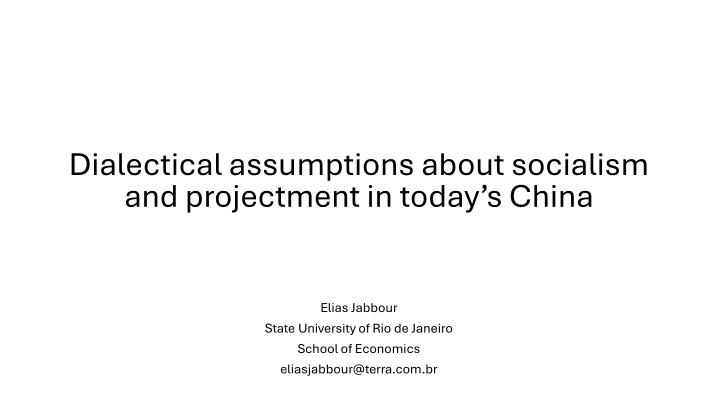
Dialectical Assumptions on Socialism and Projectment in Modern China
Explore the intricate analysis of Chinese socialism through dialectical assumptions, challenging conventional perspectives and elucidating the unique path of development China has taken. Delve into the conceptual framework that shapes China's socialist state and its distinctiveness in the global arena.
Download Presentation

Please find below an Image/Link to download the presentation.
The content on the website is provided AS IS for your information and personal use only. It may not be sold, licensed, or shared on other websites without obtaining consent from the author. If you encounter any issues during the download, it is possible that the publisher has removed the file from their server.
You are allowed to download the files provided on this website for personal or commercial use, subject to the condition that they are used lawfully. All files are the property of their respective owners.
The content on the website is provided AS IS for your information and personal use only. It may not be sold, licensed, or shared on other websites without obtaining consent from the author.
E N D
Presentation Transcript
Dialectical assumptions about socialism and projectmentin today s China Elias Jabbour State UniversityofRio de Janeiro SchoolofEconomics eliasjabbour@terra.com.br
In search for a theory In search for a theory With the country s growing influence over the world has made understanding China the order of the day. This presentation intends to confront this investigation in order to overcome the common understanding that frames the Chinese experience in fixed analytical categories, seeking to configure a new rational determination in which the concept manifests itself in real movement .
Because it is an experience that unfolds in the context of the anti-imperialist struggle, we admit that Chinese socialism develops based on Marxism as a science of political power in opposition to the postulates of the so-called Western Marxism .
We argue that, without a new cognitive grammar that allows thinking and knowing the flow of the totality of opposites of historical being, social science will make little progress in the production of theories, concepts and categories that correspond to an in-depth vision of unique phenomenon in history.
1. 1. A point A point and and the the key key categories categories - China is not a latecomer or Asian developmental state ; entreperneushipstate or even a developmental state - China as a SocialistState - China found a distinct way for development - Uneven development, projectment and socialism as key categoriesto understandthe Chinese path
2. A short introduction How How classify classify China? China? -Free market? State Capitalism? Developmental State? A consensus ( End of History ): China becamea capitalist country sincethe 1978 s - The Chinese particularity: lies in that the poorest country in the world undergoes a transformation process that leads it to be the second world economic power
3. China as a new 3. China as a new socioeconomic socioeconomic formation formation - Socialism in China reinvented through marketinstitutions - Rural reformsand emergence of new formsof property - Waves of institutional inovations - Emergence of new and higher forms of economic planning - New scientific body tounderstand the Chinese phenomena - Starting points: categories of uneven development , projectment and socialism
4. The 4. The unequal unequal development development The Lenin smain economic discover The law of uneven development has (...) a considerable importance by itself and the consequences it carries along. It is the main discovery made by Lenin in the economic field: the great law of socioeconomic formation. (Lefebvre, 1955 [2020], p. 193)
4. The 4. The unequal unequal development development - China as empirical case of theoretical comprovation of this law - In internal plan: how China use this law to planning its development As the fundamental law of socioeconomic formation and of transition periods from capitalism to socialism, we assume that uneven development operates in China with peculiarities little explored by the dominant views. If disparities in development levels between countries are a intrinsic characteristic of capitalism, we should also be able to watch them working in the countries' internal development dynamics, given their differences according to regions and modes of production structured in specific internal socioeconomic formations (Jabbour, Boa Nova, Vadell, 2023, p. 381) - Non-public forms of property and the action of law and value are important characteristics to identify how operates this law in Chinese territory and society
5. The 5. The projectment projectment - Brazilian original idea by economist Ignacio Rangel - Projectment as the fusion between Soviet planning + Keynesian Consensus + financial capital - Uneven development opens up wide possibilities to interpret the distinct national paths to socialism - The point: relations between human and nature = projectment - Effort to combine uneven development as a fundamental law of transition from capitalism to socialism + higher and superior forms of economic planning - Fusion between macro and microecnomy The category The category Two fundamental concepts: cust and benefit Objective: find a reason reason in the relation between cust and benefit
5. The 5. The projectment projectment ( ) the very conceptual definition of socialism emerging in China is now under the understanding of what we call strategic sense of reason " (Jabbour et al., 2021). Three historical process to understand the emergency of a new Three historical process to understand the emergency of a new projectment China China projectment in in - Emergence of the formation of 199 Large State-Owned Enterprise Conglomerates (LSEC). During this process, changes took place in the planning procedures: a previously central planning was replaced by a market-based planning. - The second process we refer to was when, in 2003, China created the State- Owned Assets Supervision and Administration Commission of the State Council (SASAC) as a key institution of market socialism , with the mission to manage state assets in the main LSEC. - Significant process is found in the strategic decision taken in the 11th Five Year Plan (2006-2010) to recreate a national system of technology and innovation as an environment formed by the LSEC, private conglomerates, public financial system, research centers and universities.
5. The 5. The projectment projectment - We don t observe the Chinese innovation system merely as a means to attain economic goals, but as an instrument to feed the State and the public productive base with economic forces to complement the inauguration of superior forms of economic planning; - Big Data, 5G, Artificial Intelligence; - Reaction to financial crisis (2009) - Covid-19 - Fighting against extreme poverty
5. The 5. The projectment projectment The category of ProjectmentEconomy" must be incorporated as part of the Chinese path . Our turning point in regards to dominant postulates coming both from orthodoxy and heterodoxy lies in the perception that China is now in a new kind of accumulation process, where the overcoming of all types of restrictions and the introduction of new technologies in the economy opened ways to qualitatively increase the rationality of productive processes, consequently turning the Chinese economy into a true machine of large public assets, and even of use value (Jabbour et al, 2020)
6. 6. Socialism Socialism - Socialism must be treated as a historical category; - its definition must be reached through its historical developments as much as its manifestation in current reality - The centrality of public property and a Communist Party-led Development - New importance for the category of socioeconomic formation - What matter: the exercise of political power in sense of human emancipation - Marxism: science of political power
6. 6. Socialism Socialism Unevendevelopmentand projectmentin line with a the approach on scienceof political power The proletariat will use its political supremacy to overtake, little by little, all capital from the bourgeoisie, in order to centralize all instruments of production in the hands of the State, that is, the organized working class turned into dominant class, and to enhance, as fast as possible, the sum total of productive forces. (Marx and Engels, [1848] 1998, p. 56)
6. 6. Socialism Socialism - Centralizing the strategic means of production in the State, as a way to ensure a material base for the new political power and retain a dominating planning power over the economic cycles, are the fundamentals of power exertion under socialism; - A central point: A society does never disappear before all productive forces it may contain are developed, and the new and superior productive relations never take their place before the material conditions for these relations have been inoculated in the very bosom of that old society. (Marx, [1859] 2008, p. 48 - Socialism is a path, not a model - A Prussian way?
6. 6. Socialism Socialism The main contradiction China s overall productive forces have been significantly improved from the supply perspective. As a result, China s production capacity has led the world in many areas, and its backwardness of social production has been fundamentally reversed. However, the more significant problems are that its development is inadequate overall and unbalanced between parts of the country and society. Its development is also behind some global economic powerhouses to some extent, and the structural problems are evident. These have turned into significant constraints while meeting people s growing needs for a better life. (Fang & Xiaojing, 2022, p. 38
6. 6. Socialism Socialism - Imperative the control the disorderd capital growth - Socialism in China breaks away with childish visions about post-capitalista societies; - Socialism as a embryonic form ( ) financialization created its own negation when it allowed for the emergence of a society founded on the turning of reason into an instrument of government, to be used in favor of the vast majority of the population. A kind of science-led government, managing historic issues of international communism with particular solutions. Whether it shows up through the birth of a non-liberal democracy based on communities and urban neighborhoods, whether by the slow uptake of private property into the strategic interests of the socialist State. (Jabbour et al, 2023)
Thank Thank you you! !






















